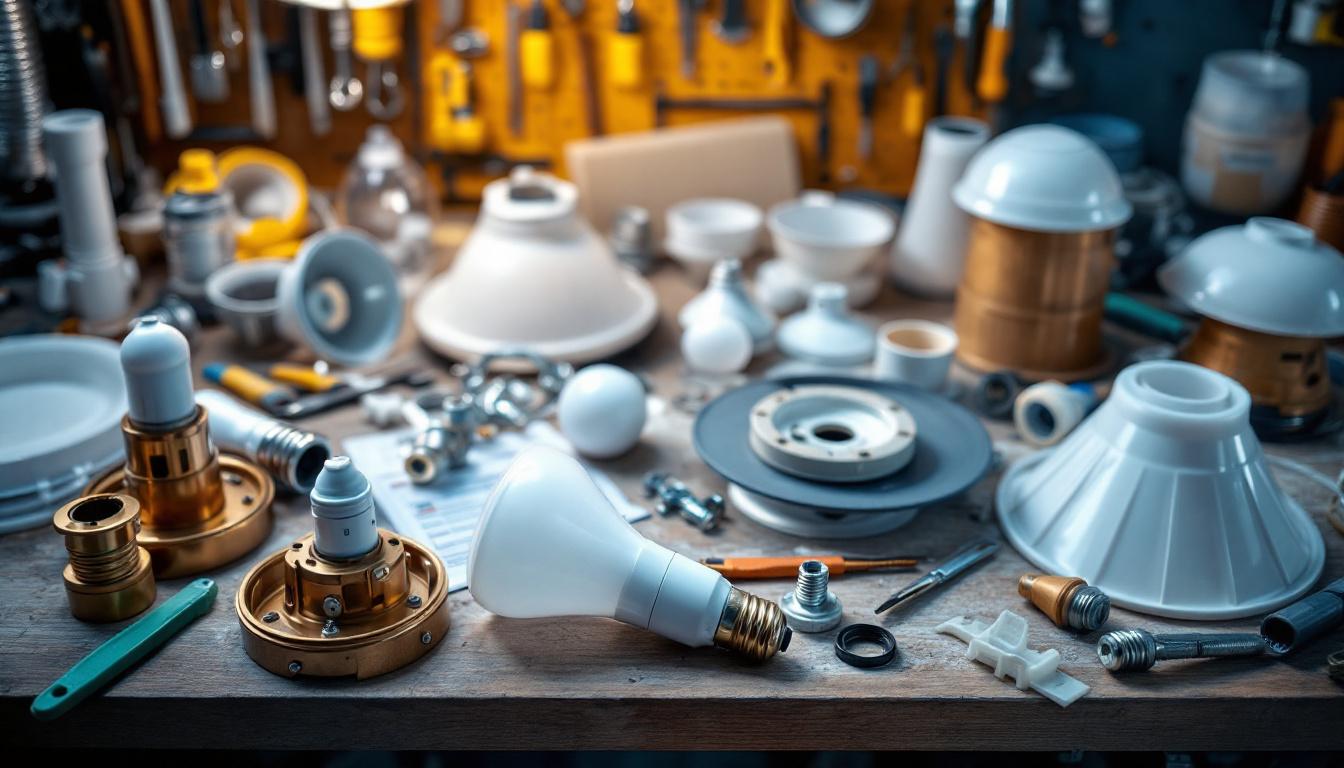
Ceiling fans are not just functional; they also serve as decorative elements in a space. For lighting contractors, understanding the various parts of ceiling fan lamps is essential for installation, maintenance, and repairs. This checklist will guide contractors through the essential components, ensuring that every job is completed with precision and professionalism.
From the motor to the light fixtures, each part plays a crucial role in the overall performance of the ceiling fan. Familiarity with these components will not only enhance the contractor’s expertise but also improve customer satisfaction. This article will delve into the key parts of ceiling fan lamps, providing a comprehensive overview that can be utilized in various projects.
One of the most critical components of a ceiling fan lamp is the motor, which drives the fan blades and regulates airflow. The efficiency of the motor directly influences the fan’s performance, making it essential for contractors to select high-quality motors that offer durability and energy efficiency. Additionally, understanding the different types of motors—such as AC and DC motors—can help contractors make informed decisions based on the specific needs of their clients. A well-functioning motor not only ensures optimal airflow but also contributes to the longevity of the ceiling fan.
Another important aspect to consider is the light fixture itself, which can vary widely in design and functionality. From integrated LED lights to traditional bulb sockets, the choice of light fixture can significantly impact the ambiance of a room. Contractors should be well-versed in the different types of bulbs compatible with ceiling fans, including incandescent, CFL, and LED options, as well as their respective energy consumption and brightness levels. Furthermore, the aesthetic appeal of the light fixture can enhance the overall design of the space, making it crucial for contractors to understand the various styles available, from modern to vintage, to meet the diverse preferences of their clients.
The motor is the heart of the ceiling fan, responsible for driving the blades and ensuring smooth operation. Most ceiling fans use either an AC or DC motor. AC motors are more common and generally less expensive, while DC motors are known for their energy efficiency and quieter operation.
When selecting a motor, contractors should consider the fan’s size and intended use. A larger motor may be necessary for bigger rooms or outdoor spaces, while smaller motors are suitable for compact areas. Additionally, understanding the wattage and RPM (revolutions per minute) can help in determining the fan’s effectiveness and efficiency.
Fan blades are crucial not only for aesthetics but also for airflow efficiency. The material and design of the blades can significantly impact performance. Common materials include wood, plastic, and metal, each offering different benefits in terms of durability and style.
Blade pitch, or the angle of the blades, also affects airflow. A higher pitch can move more air, making it ideal for larger spaces. Contractors should ensure that the blades are balanced and properly aligned to prevent wobbling and noise during operation.
Many ceiling fans come equipped with integrated light fixtures, which can enhance the functionality of the fan. These fixtures can vary widely in style, from traditional incandescent bulbs to modern LED options. Understanding the different types of bulbs and their compatibility with the fan is essential for a successful installation.
Contractors should also consider the wattage and lumens of the light fixtures. This ensures that the lighting is adequate for the space and meets the client’s needs. Additionally, dimmable options can provide versatility, allowing for different lighting moods throughout the day.
Proper wiring is crucial for the safe operation of ceiling fans. Contractors must be familiar with local electrical codes and standards to ensure compliance. Typically, ceiling fans require a dedicated circuit, especially if they have integrated lighting.
When wiring a ceiling fan, it’s important to use the correct gauge of wire. A thicker wire is necessary for higher wattage fans, while thinner wire may suffice for smaller models. Ensuring that connections are secure and insulated can prevent electrical hazards and enhance the longevity of the installation.
Ceiling fans can be operated through various controls, including pull chains, wall switches, or remote controls. Each option has its advantages, and the choice often depends on the client’s preferences and the room layout.
When installing switches, contractors should ensure that they are compatible with the fan’s motor and lighting system. Additionally, smart controls are becoming increasingly popular, allowing users to operate their fans through smartphones or voice commands. Familiarity with these technologies can set a contractor apart in a competitive market.
Capacitors play a vital role in regulating the speed of the fan. They help in starting the motor and maintaining its efficiency. Understanding how to troubleshoot and replace capacitors can save time and enhance service quality.
Speed control options, whether through a pull chain or remote, should be tested during installation. Ensuring that each speed setting functions correctly is crucial for customer satisfaction. A fan that operates smoothly and quietly at all speeds will likely lead to positive reviews and repeat business.
Standard mounting is the most common installation method for ceiling fans. This involves attaching the fan directly to the ceiling joist. It’s essential to ensure that the mounting bracket is securely fastened and that the fan is level for optimal performance.
Contractors should also consider the height of the ceiling when installing standard mounts. Fans should be installed at least seven feet above the floor for safety and efficiency. In rooms with higher ceilings, downrods may be necessary to lower the fan to the appropriate height.
Flush mounting is ideal for rooms with low ceilings. This method involves attaching the fan directly to the ceiling without any downrod. While this can save space, it may limit airflow compared to standard mounting.
When using flush mounts, it is important to select fans specifically designed for this installation type. These fans typically have a lower profile and are engineered to maximize airflow despite the reduced height.
For ceilings that are sloped or angled, specialized mounting kits are available. These kits allow the fan to hang level, ensuring optimal performance. Contractors should assess the angle of the ceiling before installation to determine the best mounting solution.
Proper installation of angled mounts is crucial, as improper alignment can lead to wobbling and noise issues. Ensuring that the fan is balanced and securely mounted will enhance its longevity and performance.
Regular maintenance is key to ensuring the longevity and efficiency of ceiling fans. Dust and debris can accumulate on the blades, affecting performance and airflow. Contractors should recommend regular cleaning to clients, emphasizing the importance of keeping the fan in optimal condition.
Additionally, checking for loose screws and connections can prevent potential issues down the line. A simple inspection can save time and money by addressing minor problems before they escalate.
Even with proper installation and maintenance, ceiling fans may encounter issues. Common problems include wobbling, noise, or failure to operate. Understanding how to troubleshoot these issues can enhance a contractor’s reputation and reliability.
Wobbling can often be resolved by ensuring that the blades are balanced and that all screws are tightened. Noisy fans may require lubrication of the motor or checking for loose components. If the fan fails to operate, it may be a wiring issue or a problem with the motor or capacitor.
In some cases, replacement parts may be necessary to restore a fan’s functionality. Familiarity with common replacement parts, such as motors, blades, and capacitors, can streamline the repair process. Contractors should maintain a stock of essential parts to ensure quick turnaround times for clients.
Additionally, understanding the warranty and return policies for various fan brands can aid in providing excellent customer service. Clients will appreciate a contractor who can efficiently handle repairs and replacements without unnecessary delays.
When selecting a ceiling fan for a project, it is essential to assess the client’s needs and preferences. Factors such as room size, style, and functionality should be considered. Engaging with clients to understand their vision can lead to better recommendations and increased satisfaction.
For instance, a large living room may require a fan with a higher CFM (cubic feet per minute) rating to ensure adequate airflow. Conversely, a small bedroom may benefit from a more compact design with integrated lighting options.
Ceiling fans come in various styles, from traditional to modern designs. Contractors should stay informed about current trends and popular styles to offer clients a wide range of options. This knowledge can enhance the contractor’s credibility and help clients make informed decisions.
Incorporating unique features, such as decorative light fixtures or custom blade designs, can also set a fan apart. Understanding the interplay between functionality and aesthetics is crucial in recommending the right ceiling fan for any space.
Energy efficiency is a growing concern for many homeowners. Ceiling fans with Energy Star ratings are designed to consume less energy while providing optimal performance. Contractors should highlight the benefits of energy-efficient fans to clients, emphasizing long-term savings on energy bills.
Additionally, educating clients about the advantages of using ceiling fans in conjunction with air conditioning systems can further promote energy savings. This holistic approach to cooling and ventilation can enhance client satisfaction and loyalty.
Understanding the various parts and components of ceiling fan lamps is essential for lighting contractors. This comprehensive checklist serves as a valuable resource for ensuring successful installations and repairs. By familiarizing themselves with the motor, blades, light fixtures, and electrical components, contractors can enhance their expertise and provide exceptional service to clients.
Regular maintenance and troubleshooting knowledge further contribute to a contractor’s reliability and reputation. By staying informed about current trends and energy-efficient options, contractors can offer clients the best solutions for their needs.
Ultimately, a well-installed and maintained ceiling fan can significantly enhance a space, providing comfort and style. By following this ultimate lighting contractor checklist, professionals can ensure that every ceiling fan project is completed to the highest standards, leading to satisfied clients and successful outcomes.
Ready to elevate your lighting projects with the best in the business? Look no further than LumenWholesale for all your ceiling fan lamp parts needs. Our commitment to quality and affordability ensures that you have access to spec-grade lighting products at wholesale prices that simply can’t be beaten. Say goodbye to middleman markups and hello to a vast selection of reliable, high-performance lighting essentials. Plus, with free shipping on bulk orders, you can stock up on everything you need without worrying about extra costs. Don’t compromise on quality or price. Wholesale Lighting at the Best Value is just a click away. Choose LumenWholesale for a seamless, cost-effective shopping experience today!

Discover effective strategies for training your team in outdoor lighting with our comprehensive guide on lamp posts.

Discover why staying updated on solar LED landscape lights is crucial for lighting contractors.

Discover why staying updated on LED 4 Ft lighting is essential for contractors—gain insights on energy savings, latest tech trends, and boost project efficiency.

Discover essential insights into 480 3 phase indicator lights with our expert tips tailored for lighting contractors.